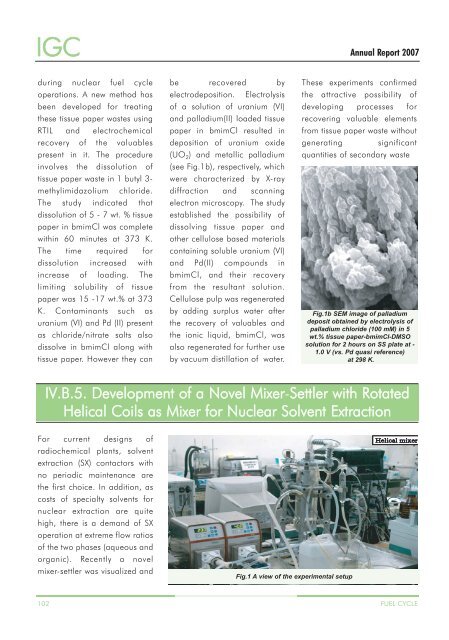IGCAR : Annual Report - Indira Gandhi Centre for Atomic Research
IGCAR : Annual Report - Indira Gandhi Centre for Atomic Research
IGCAR : Annual Report - Indira Gandhi Centre for Atomic Research
Create successful ePaper yourself
Turn your PDF publications into a flip-book with our unique Google optimized e-Paper software.
IGC<br />
<strong>Annual</strong> <strong>Report</strong> 2007<br />
during nuclear fuel cycle<br />
operations. A new method has<br />
been developed <strong>for</strong> treating<br />
these tissue paper wastes using<br />
RTIL and electrochemical<br />
recovery of the valuables<br />
present in it. The procedure<br />
involves the dissolution of<br />
tissue paper waste in 1 butyl 3-<br />
methylimidazolium chloride.<br />
The study indicated that<br />
dissolution of 5 - 7 wt. % tissue<br />
paper in bmimCl was complete<br />
within 60 minutes at 373 K.<br />
The time required <strong>for</strong><br />
dissolution increased with<br />
increase of loading. The<br />
limiting solubility of tissue<br />
paper was 15 -17 wt.% at 373<br />
K. Contaminants such as<br />
uranium (VI) and Pd (II) present<br />
as chloride/nitrate salts also<br />
dissolve in bmimCl along with<br />
tissue paper. However they can<br />
be recovered by<br />
electrodeposition. Electrolysis<br />
of a solution of uranium (VI)<br />
and palladium(II) loaded tissue<br />
paper in bmimCl resulted in<br />
deposition of uranium oxide<br />
(UO 2 ) and metallic palladium<br />
(see Fig.1b), respectively, which<br />
were characterized by X-ray<br />
diffraction and scanning<br />
electron microscopy. The study<br />
established the possibility of<br />
dissolving tissue paper and<br />
other cellulose based materials<br />
containing soluble uranium (VI)<br />
and Pd(II) compounds in<br />
bmimCl, and their recovery<br />
from the resultant solution.<br />
Cellulose pulp was regenerated<br />
by adding surplus water after<br />
the recovery of valuables and<br />
the ionic liquid, bmimCl, was<br />
also regenerated <strong>for</strong> further use<br />
by vacuum distillation of water.<br />
These experiments confirmed<br />
the attractive possibility of<br />
developing processes <strong>for</strong><br />
recovering valuable elements<br />
from tissue paper waste without<br />
generating significant<br />
quantities of secondary waste<br />
Fig.1b SEM image of palladium<br />
deposit obtained by electrolysis of<br />
palladium chloride (100 mM) in 5<br />
wt.% tissue paper-bmimCl-DMSO<br />
solution <strong>for</strong> 2 hours on SS plate at -<br />
1.0 V (vs. Pd quasi reference)<br />
at 298 K.<br />
IV.B.5. Development of a Novel Mixer-Settler with Rotated<br />
Helical Coils as Mixer <strong>for</strong> Nuclear Solvent Extraction<br />
For current designs of<br />
radiochemical plants, solvent<br />
extraction (SX) contactors with<br />
no periodic maintenance are<br />
the first choice. In addition, as<br />
costs of specialty solvents <strong>for</strong><br />
nuclear extraction are quite<br />
high, there is a demand of SX<br />
operation at extreme flow ratios<br />
of the two phases (aqueous and<br />
organic). Recently a novel<br />
mixer-settler was visualized and<br />
Fig.1 A view of the experimental setup<br />
Helical mixer<br />
102 FUEL CYCLE

















